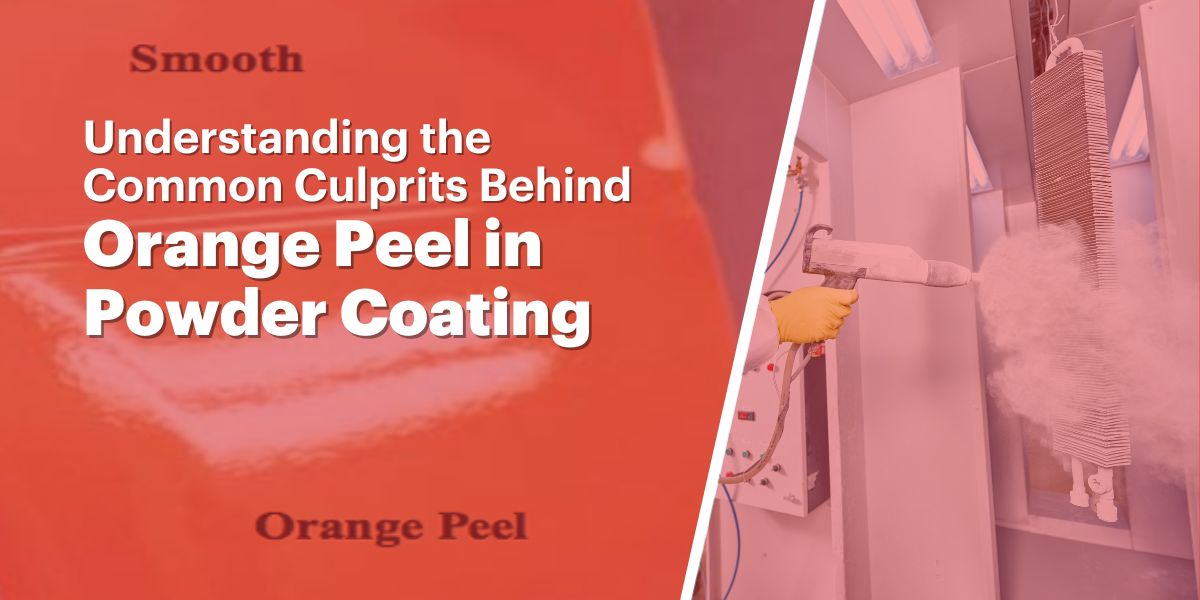Understanding the Common Culprits Behind Orange Peel in Powder Coating Finishes
As an expert in the powder coating industry, we understand the importance of achieving flawless powder coating finishes. However, there are instances when an unwanted texture, commonly known as “orange peel,” mars the otherwise smooth appearance. Orange peel is characterized by a bumpy, textured surface that resembles the peel of an orange and it can be a frustrating challenge for powder coating applicators.
Powder coating is a dry coating process used on metal or articles surface finishes. Powder coating finishes is mostly applied dry powder through an electrostatic process, then cured with heat. In this knowledge series blog, we will explore the top 10 reasons for orange peel in powder coating finishes and offer insights into mitigating these issues to achieve exceptional powder coating results.
What is Orange Peel in Powder Coating?
Orange peel is a surface texture defect that resembles the dimpled or textured skin of an orange. Instead of a smooth and uniform finish, the coated surface appears uneven and textured. This issue can compromise the aesthetics and functionality of the coated product.
Causes of Orange Peel:
-
Powder Particle Size:
If the powder particles are too large, they might not melt and flow together properly during the curing process, leading to an uneven surface.
-
Film Thickness:
An excessively thick or thin coating can contribute to orange peel. It’s crucial to adhere to the recommended film thickness for the specific powder coating.
-
Curing Temperature and Time:
Incorrect curing temperature and duration can result in improper flow and leveling of the powder, leading to orange peel.
-
Humidity and Environmental Conditions:
High humidity levels during the curing process can affect the flow and appearance of the coating, causing orange peel.
Achieve Exceptional Powder Coating Finishes.
-
Incorrect Coating Thickness:
Applying an inconsistent or excessively thick coating can lead to uneven texture, resulting in orange peel. Precise control of coating thickness during the powder coating process is essential to achieve a smooth and uniform finish.
-
Inadequate Preheating:
Insufficient preheating of the substrate can cause poor powder flow and adhesion, leading to orange peel. Proper preheating is crucial to ensure the substrate is at the optimal temperature for powder adhesion.
-
Poor Grounding:
Improper grounding can cause uneven distribution of the powder particles, resulting in an irregular coating surface. Ensuring excellent grounding during the powder coating finishes is vital for preventing orange peel.
-
Incorrect Curing Temperature:
Inconsistent curing temperatures can disrupt the flow and leveling of the powder, leading to an orange peel texture. Precise control of the curing temperature is essential for achieving a smooth and glossy finish.
-
Contamination:
Contaminants on the substrate or in the powder can negatively impact the powder coating process, causing irregularities like orange peel. Thoroughly clean and maintain both the substrate and powder to avoid contamination issues.
-
Humidity:
High humidity levels in the environment can interfere with the powder’s ability to flow smoothly, resulting in orange peel. Ensure proper humidity control in the powder coating plant to prevent this problem.
-
Poor-Quality Powder:
Using low-quality or expired powder can lead to inconsistent powder flow and adherence, causing orange peel. Invest in premium-grade powder from reliable suppliers for better results.
-
Incorrect Spraying:
Improper powder spraying techniques, such as using excessive pressure or improper gun-to-substrate distance, can contribute to orange peel. Proper training and technique are essential for achieving a uniform powder coating finishes.
-
Substrate Preparation:
Insufficient surface preparation, such as inadequate cleaning or surface roughness, can lead to poor powder adhesion and orange peel. Thoroughly prepare the substrate before powder coating to ensure proper adhesion.
-
Powder Gun Issues:
Issues with the powder gun, such as clogged nozzles or incorrect gun settings, can cause uneven powder distribution and contribute to orange peel. Regular maintenance and calibration of the powder gun are crucial to prevent this problem.
Intech Surfacing as a pioneer in surface coating technology in India, achieving flawless powder coating, free from the vexing orange peel effect, demands a comprehensive approach encompassing powder attributes, application precision, and controlled curing conditions. We emphasize the importance of attention to detail and precise control throughout the powder coating process to achieve flawless finishes. By addressing the top 10 reasons for orange peel – including incorrect coating thickness, inadequate preheating, poor grounding, and others – powder coating applicators can overcome this challenge and deliver exceptional results. Invest in high quality materials, maintain proper equipment, and prioritize a well-executed powder.


